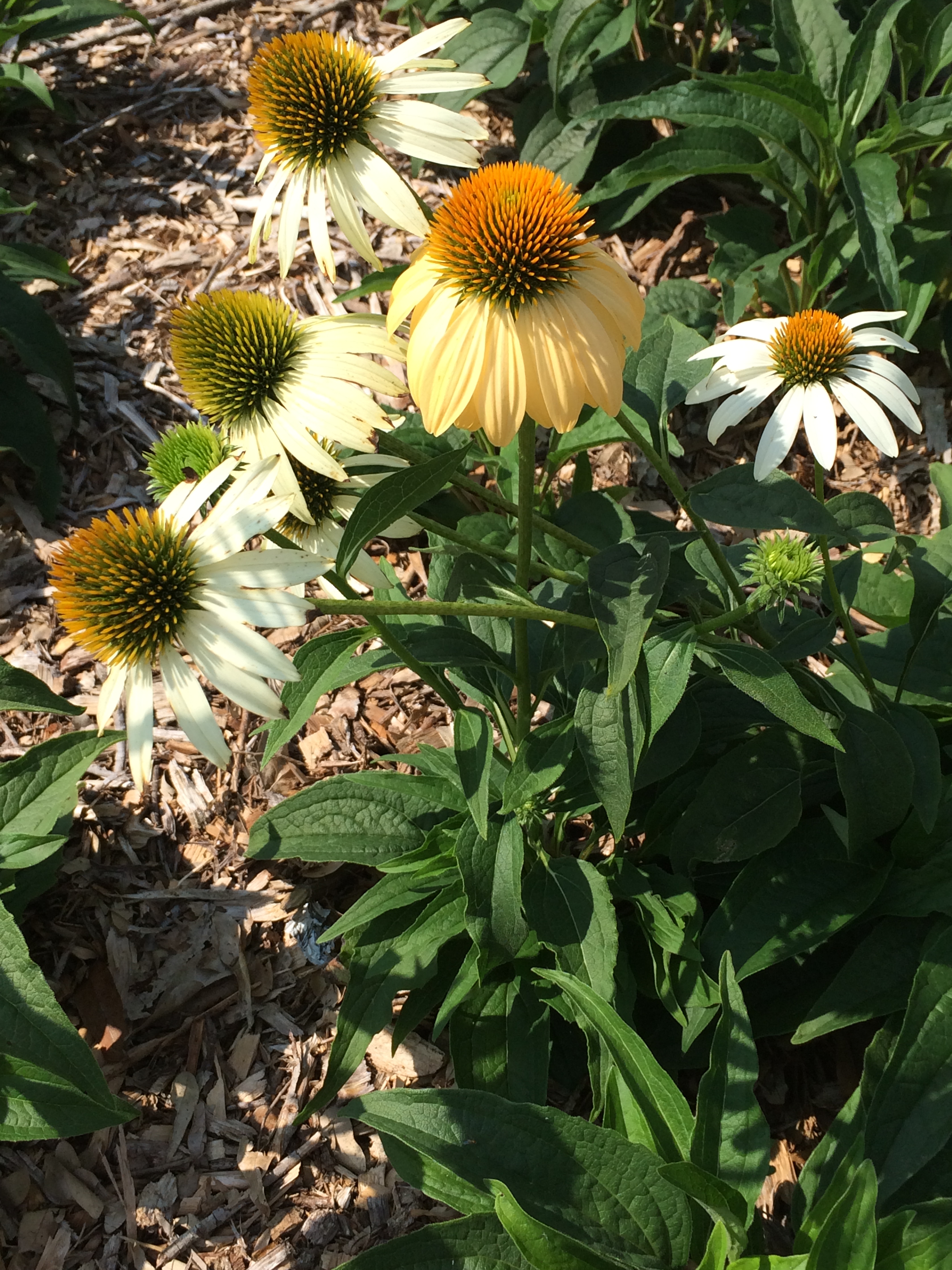
by Mary Salinas | May 12, 2015
An easy to care for perennial to add to your flower garden is the coneflower, Echinacea purpurea. The daisy-like flowers stand tall above the foliage on sturdy 2 to 4 foot stems. Blooms appear about the last part of April or the first of May in the Florida panhandle and last throughout the warm season until late fall. This Florida native reliably comes back year after year. Plant coneflower in part to full sun in rich but well-drained soil for best results.
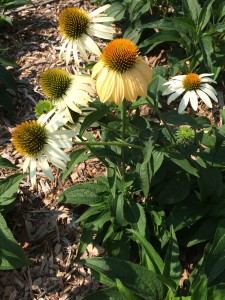
White coneflower. Photo credit: Mary Derrick, UF/IFAS Extension.
Coneflowers are traditionally purple but many new colors and variations of their form have become available from the horticultural industry. You can find them in white, yellows, pinks, oranges, and greens as well as all shades of lavender and purple. No matter what color you choose, the blooms will attract a host of butterflies and other pollinating insects. In order to protect these delicate creatures, avoid the use of pesticides when they are present.
Once you have a few coneflowers, you will notice that the clumps will grow in time and new plants will sprout from seeds left behind by the spent blooms. In our demonstration garden, this has created a stunning display that has been allowed to take over one of the garden beds. When any one clump gets too big, the number of blooms can decrease and it may be time to dig up the clump and divide it. This is a great opportunity to expand your coneflower bed or share them with some friends or neighbors!
For more information:
Ornamentals for your landscape
Butterfly Gardening
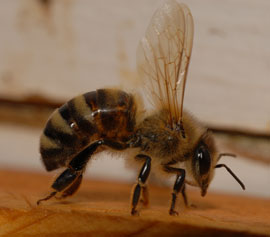
by Sheila Dunning | Apr 28, 2015
Bees have been disappearing at an alarming rate and continue to vanish without a trace. Why should anyone care? Well, they matter a lot more than most people think. Bees are the overwhelmingly dominant pollinator for most food crops. Native bees in the United States are responsible for pollinating over $15 billion worth of agricultural commodities annually. However, native bee populations are in decline due to habitat loss. At the same time, managed colonies of European honey bees have suffered a 50% decline over the past few decades. Numerous other pollinating insects are facing the same fate.

European honey bee. Photo credit: UF/IFAS.
As the spring planting season is upon us, it’s exciting to think about all the wonderful produce we will have this summer. But, without pollinators many of these crops would not be available. The majority of fruit and vegetable food sources we eat are dependent on insect pollinators. One of every three bites of food Americans consume comes from a plant visited by bees or other pollinators.
As declining numbers of farmers work to meets the need of increasing populations, they are forced to make choices on alternative to chemicals for pest control. “Good bug blends” of flowers can help attract pollinators as well as beneficial insects that suppress harmful pests. Establishment of these meadows can be done on a small or large scale and in any habitat. One approach to “bring back the pollinators” is to intercrop with blooming plants that attract insects. Selecting a diversity of plants with different flower sizes, shapes and colors, as well as various plant heights and growth habits, will encourage the greatest numbers of pollinators. It is important to provide a continuous source of pollen and nectar throughout the growing season. At minimum, strive for three species to be blooming at any one time; the greater the diversity the better.
To enhance the garden, choose flowering plants that also provide shelter for beneficial insects. Many companion plants are suitable habitat for predators and parasitoids. Research in Florida has demonstrated that predatory minute pirate bugs can build to high numbers in sunflowers. The favorite food of minute pirate bugs is Western flower thrips. So, planting sunflowers on the perimeter of vegetable crops, such as peppers, can greatly reduce the damage caused by the thrips. Similar results were found with the planting of sorghum to attract beneficial mites and intercropping with buckwheat to house syrphid flies and parasitoid wasps. The garden vegetables experienced fewer spider mite, whitefly and aphid problems. Crimson clover, Hairy vetch and cosmos are other annual seed crops that can aid in attracting pollinators and harboring beneficial insects.
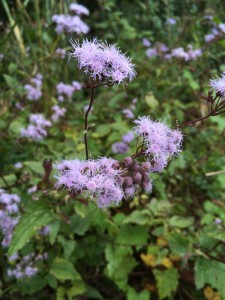
Blue Mistflower. Photo Credit Mary Derrick, UF / IFAS Extension.
Insectary meadows can be created in the landscape and along roadways, not just in the garden. For more permanently planted areas, native wildflowers, grasses and woody plants serve as larval host plants for butterflies, and also provide nesting and overwintering sites for bumble bees, predacious beetles and other beneficial insects. Native perennial wildflowers such as blanketflower, tickseed, black-eyed Susan, partridge pea, narrowleaf sunflower, milkweed, beebalm, goldenrod and silkgrass can be installed in the spring as potted plants or seeded in the fall. Seeds require exposure to cold temperatures and damp conditions before germination can occur. In Florida, the best time is November to February.
Though grasses do not offer nectar or high-quality pollen, it is often useful to include at least one native bunch grass or sedge. Short, clump-forming grasses are preferable to large, spreading grasses. Hedgerow planting of woody species is a way to provide winter-blooming plants vital for supporting pollinators. Woody plants and grasses provide more than forage for pollinators, as many native bee species nest in the stems of plants or in the undisturbed ground underneath plantings. Suitable grasses include: beaked panicgrass, purple lovegrass, Muhly grass, broomsedge,little bluestem, wiregrass and toothache grass. Favored woody species that make good “beetle banks” include: fetterbush, American beautyberry, saw palmetto, Chickasaw plum, red maple, sparkleberry, Dahoon holly, redbud, blackgum, magnolia, buttonwood and sourwood.
Regardless of whether the objective is to establish herbaceous or woody vegetation, the time and effort spent on eradicating undesirable plants prior to planting will result in higher success rates in establishing the targeted plant community. Choose level, open sites that receive full sunlight and have limited weed populations. If perennial weeds are a problem, the use of herbicides that have no soil residual (e.g. glyphosate) may be necessary.
For more information on establishing planting for pollinators visit: www.xerces.org/pollinator.
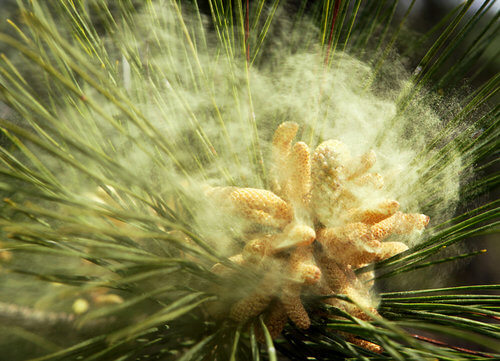
by Taylor Vandiver | Mar 24, 2015
It’s that time of year again, that time when your car changes color like a chameleon in order to mimic the surrounding landscape. Anything that stands still long enough will become coated with a light green to yellow dust. What is this dust you might ask? What you are seeing is pollen, a sure sign that spring has arrived and allergy season is here! The pollen that can be seen is from pine trees and is not a major contributor to allergies, but the invisible pollen from oak trees and other plants can wreak havoc on sinuses. And while you may be cursing the trees for causing your eyes to water and coating your car, it’s important to remember that plants need pollen in order to reproduce.

Pollen disseminating from a pine tree anther. Picture courtesy of http://supermanherbs.com/megadose-pine-pollen/
Pollen is disseminated from blooming trees and plants. The process of pollination develops new plant seeds. Pollen is dry and light, enabling it to float through the wind and travel several miles. Plants that depend on wind for dispersal have to produce massive amounts of pollen since only a small amount will actually result in seed production. Plants pollinated by insects don’t have to produce as much pollen because of the efficiency of the insects in distributing the pollen. Changes in the weather directly influence the amount of pollen and how it will affect allergy sufferers. Rain dampens pollen and reduces its ability to flow through the air. A freeze can also slow down a tree’s rate of producing pollen. Windy and warm weather can increase pollen amounts.
A Leon County allergy and asthma specialist stated that roughly 40 percent of the population suffers from pollen allergies. The best thing you can do if you are part of this 40 percent is to reduce your exposure to pollen. Here are a few ways you can keep your allergies at bay:
- Dry clothes in an automatic dryer rather than hanging them outside to avoid pollen collecting on clothing and being carried indoors.
- Consider limiting outdoor activities during the pollen season (Florida trees often release pollen from January to June).
- Stay inside during peak pollen times (from 10 a.m. to 4 p.m.).
- Restrict outdoor activities during days with high winds and low humidity.
- Shower after spending time outdoors to remove pollen from hair and skin.
- Use air filters and clean regularly, or run an air conditioner and change the air filter frequently.
- Wear a dust mask when mowing the lawn, gardening, or raking leaves.
If you would like to know what trees are producing pollen in your area at certain times of the year you can visit this website http://www.pollenlibrary.com/State/Florida/. As always, feel free to contact your local Extension Office for more information.
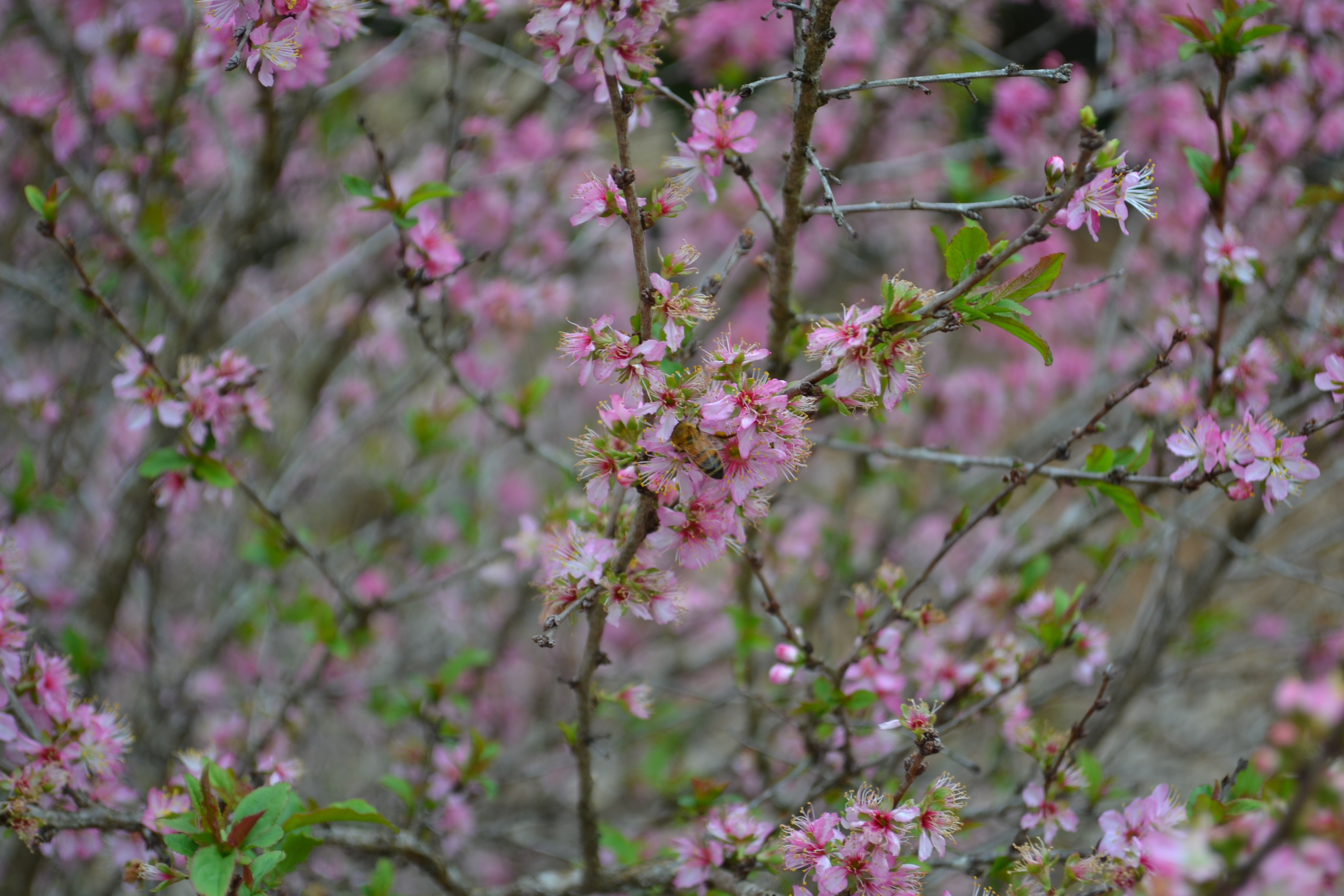
by Beth Bolles | Mar 10, 2015
Although we are not able to grow edible cherry trees in more southern climates, there are a few ornamental relatives of the cherry that are worth adding to the landscape. The Bush cherry, Prunus jacquemontii, is an attractive deciduous shrub that is a highlight with pink blooms in late winter. Flowers provide an early nectar source to bees.
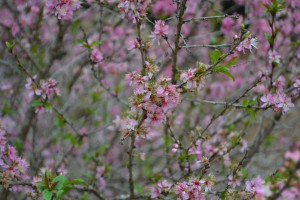
Bees are actively visiting flowers.
Plant the bush cherry is an area that receives sunlight and allows for the rounded shrub to grow about 5 feet by 5 feet. Plants like well-drained soil but benefit from some moisture during the growing season. Small berries serve as a food source for wildlife and can be used in jellies and jams. Leaves turn yellow in the fall before dropping. Plants are generally low maintenance and certainly brighten winter days. 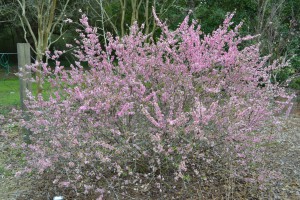
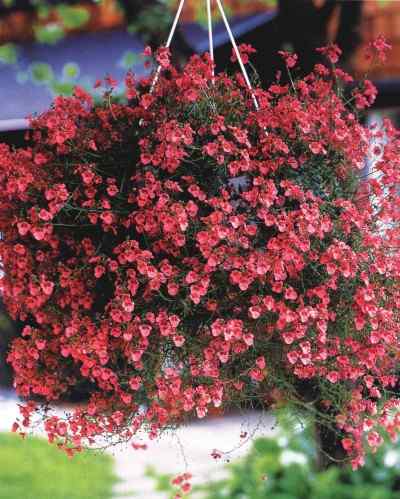
by Sheila Dunning | Nov 4, 2014
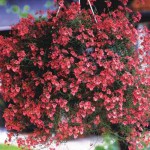 Since 2005, multiple varieties of Diascia have added to the U.S. fall market of winter flowering plants. Its delicate flowers are far from ordinary though. In the early part of the last century most British gardening encyclopedias listed just one diascia – Diascia barberae – derived from seed collected by Col. J. H. Bowker and sent by Mrs. Barber to Kew Gardens, England, in 1870. Annual and perennial diascias had, of course, already been discovered and classified by several botanists visiting South Africa much earlier. The dainty, little annual, Diascia barberae, is not a very showy flower, but one which will appeal to the true flower lover. The flowers are rosy pink with yellow-green spots in the throat. The flowers are lipped, being related to the Snapdragons, but have two spurs on the lower lips, and are sometimes called twinspur. It was not until John Kelly was given a plant called Diascia cordata by Edrom Nurseries in 1971 that anything notable happened to diascias again. He took pollen from his Diascia cordata and applied it to one flower of Diascia barberae. Of the nine seeds he obtained, just one was worthy of attention. He named it Diascia ‘Ruby Field’ (not for the color of the flowers, but for a lady who devoted her live to the long-term care of deprived children). Despite the popularity of this new, hardy hybrid, little more happened with diascias for yet another decade. The boom in the diascia trade began only recently. Today’s diascia offers larger flowers, larger plants with a more open growth habit and colors ranging from scarlet through salmon and coral into pink. They bloom throughout the cooler weather and may behave as a perennial in warmer sites. But, the uniqueness of their flower structure and ecological role are as fascinating as the flower is beautiful.
Since 2005, multiple varieties of Diascia have added to the U.S. fall market of winter flowering plants. Its delicate flowers are far from ordinary though. In the early part of the last century most British gardening encyclopedias listed just one diascia – Diascia barberae – derived from seed collected by Col. J. H. Bowker and sent by Mrs. Barber to Kew Gardens, England, in 1870. Annual and perennial diascias had, of course, already been discovered and classified by several botanists visiting South Africa much earlier. The dainty, little annual, Diascia barberae, is not a very showy flower, but one which will appeal to the true flower lover. The flowers are rosy pink with yellow-green spots in the throat. The flowers are lipped, being related to the Snapdragons, but have two spurs on the lower lips, and are sometimes called twinspur. It was not until John Kelly was given a plant called Diascia cordata by Edrom Nurseries in 1971 that anything notable happened to diascias again. He took pollen from his Diascia cordata and applied it to one flower of Diascia barberae. Of the nine seeds he obtained, just one was worthy of attention. He named it Diascia ‘Ruby Field’ (not for the color of the flowers, but for a lady who devoted her live to the long-term care of deprived children). Despite the popularity of this new, hardy hybrid, little more happened with diascias for yet another decade. The boom in the diascia trade began only recently. Today’s diascia offers larger flowers, larger plants with a more open growth habit and colors ranging from scarlet through salmon and coral into pink. They bloom throughout the cooler weather and may behave as a perennial in warmer sites. But, the uniqueness of their flower structure and ecological role are as fascinating as the flower is beautiful. 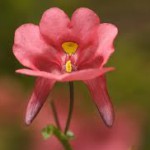 The common name of twinspur refers to the two downwardly pointing spurs found on the back of the flower. The spurs contain an oil which is collected in the South Africa wild by Rediviva bees. The female bees have unusually long, hairy forelegs that are used to collect the oil to feed her larvae. However, the Greek origin of the Diascia name doesn’t refer to the spurs, but rather the two sacs found in the upper part of the corolla. The flower petals help the bees to
The common name of twinspur refers to the two downwardly pointing spurs found on the back of the flower. The spurs contain an oil which is collected in the South Africa wild by Rediviva bees. The female bees have unusually long, hairy forelegs that are used to collect the oil to feed her larvae. However, the Greek origin of the Diascia name doesn’t refer to the spurs, but rather the two sacs found in the upper part of the corolla. The flower petals help the bees to  orient themselves to the oil glands of the spurs. While North Florida isn’t home to the Rediviva bee, we can grow Diascia and it is a wonderful opportunity to show the unique connection insects and plants can have. Look for other specialized flower structures and you will find other animals that fit them perfectly, even within the species found in the Panhandle.
orient themselves to the oil glands of the spurs. While North Florida isn’t home to the Rediviva bee, we can grow Diascia and it is a wonderful opportunity to show the unique connection insects and plants can have. Look for other specialized flower structures and you will find other animals that fit them perfectly, even within the species found in the Panhandle.
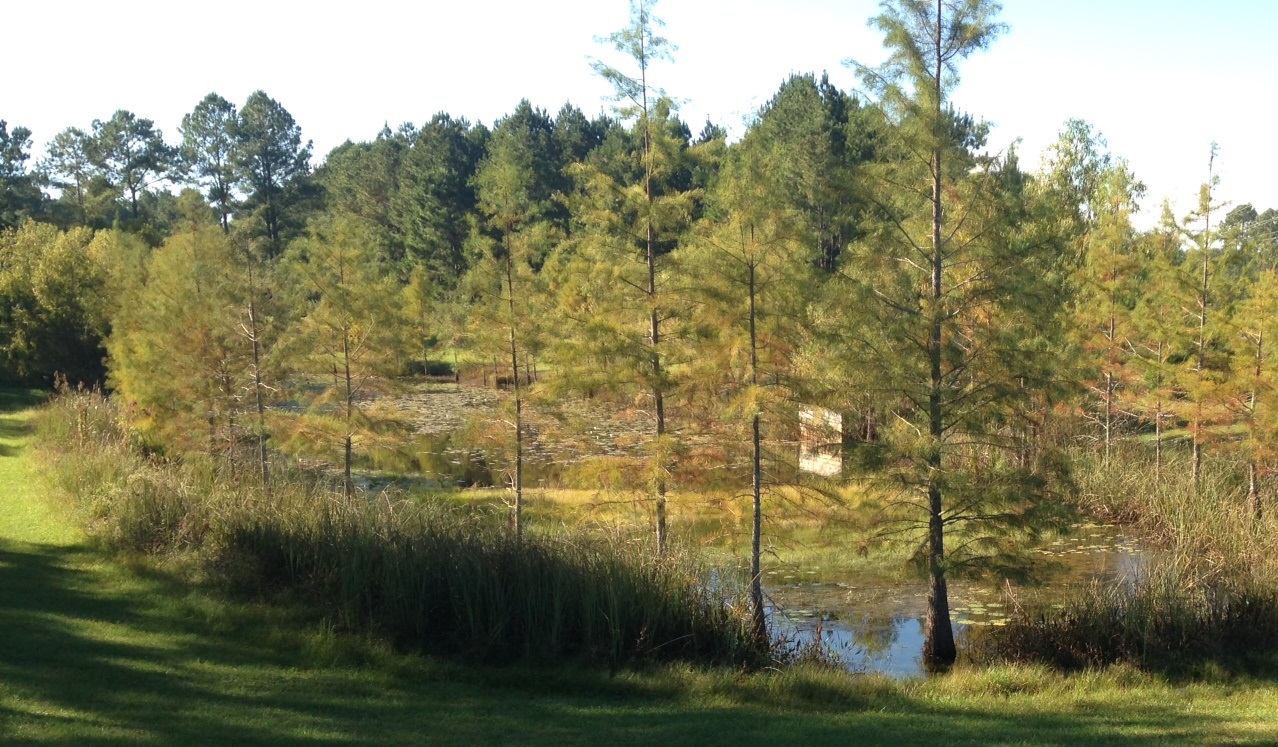
by Carrie Stevenson | Nov 4, 2014
I recently met with a group of community volunteers who are interested in providing more butterfly habitat in our public areas. Monarchs migrating to Mexico this time of year use northwest Florida as a stopover and feeding site, but if host plants are unavailable they cannot sustain a healthy population. In addition, Gulf fritillaries, buckeyes, and swallowtails are spending time in local butterfly gardens, feeding on passion vine, butterfly bush, milkweed, and more.
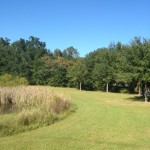
The grassy area between this stormwater pond and woods is an ideal location for a butterfly garden. Willows growing along the edge attract butterflies already. Photo credit: Carrie Stevenson
The volunteers and several county staff visited three publicly-managed stormwater ponds, which are an ideal setting for what some proponents term “Butterflyscaping.” The open space, water source, and diversity of plants along the edge of the ponds lend themselves well to wildlife habitat.
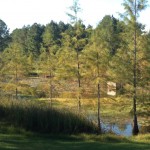
The permanently wet detention pond lined with cypress trees and sawgrass also provides habitat for fish, birds, and reptiles. Photo credit: Carrie Stevenson
When considering adding vegetation to a neighborhood common area, there are several things to consider. First is maintenance. If there’s an annual contract with a landscaping company to mow or maintain an area, you’ll want to have a discussion about excluding the new planting area from mowing to establish new vegetation. You’ll also want to look at the soil and amount of sunlight to determine the best plant choices for the area.
A variety of groundcovers, flowering plants, shrubs and small trees will typically provide food for both caterpillars and adult butterflies. Once established, these new landscape additions will not only provide habitat and color, but may end up reducing maintenance costs as well.
For more information, the UF publication “Community Butterflyscaping” is an excellent resource for landscape design, plant choices, and practical steps toward getting started with a neighborhood or schoolyard project.















